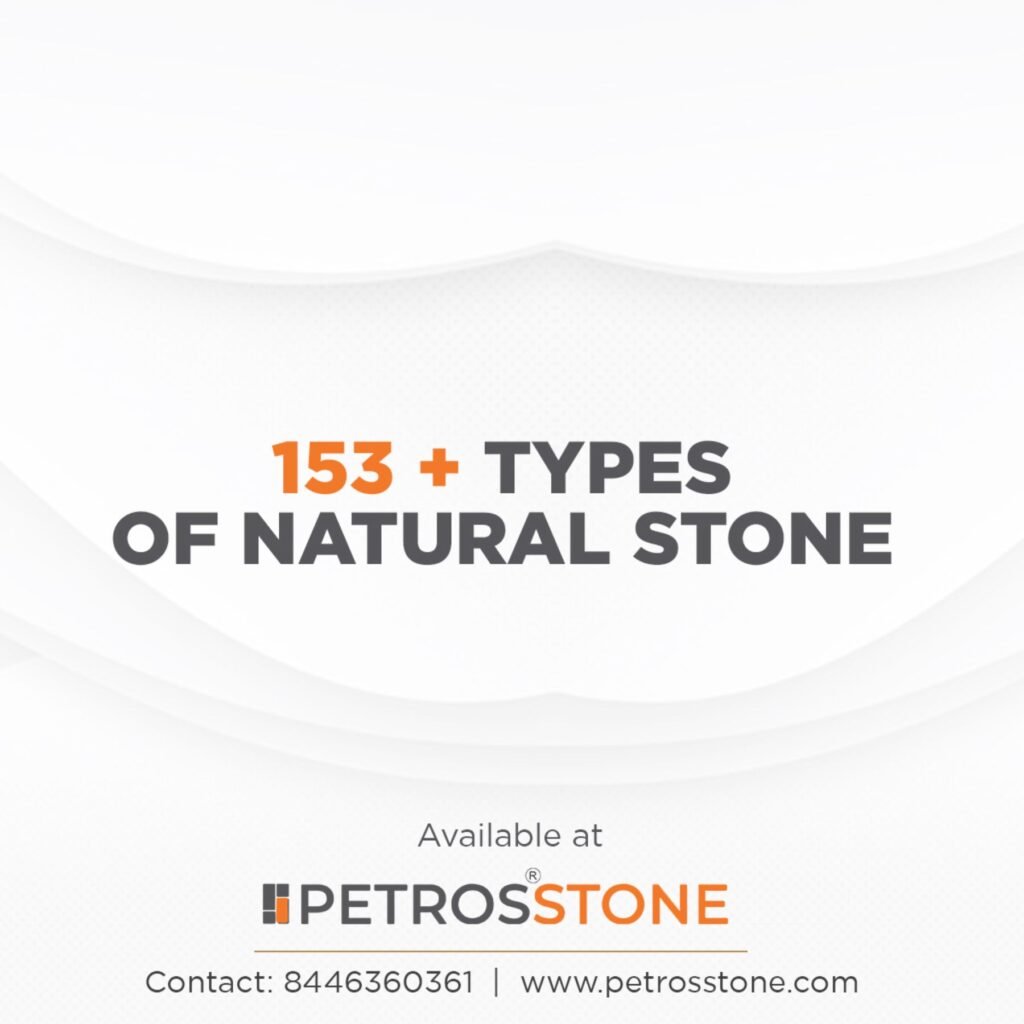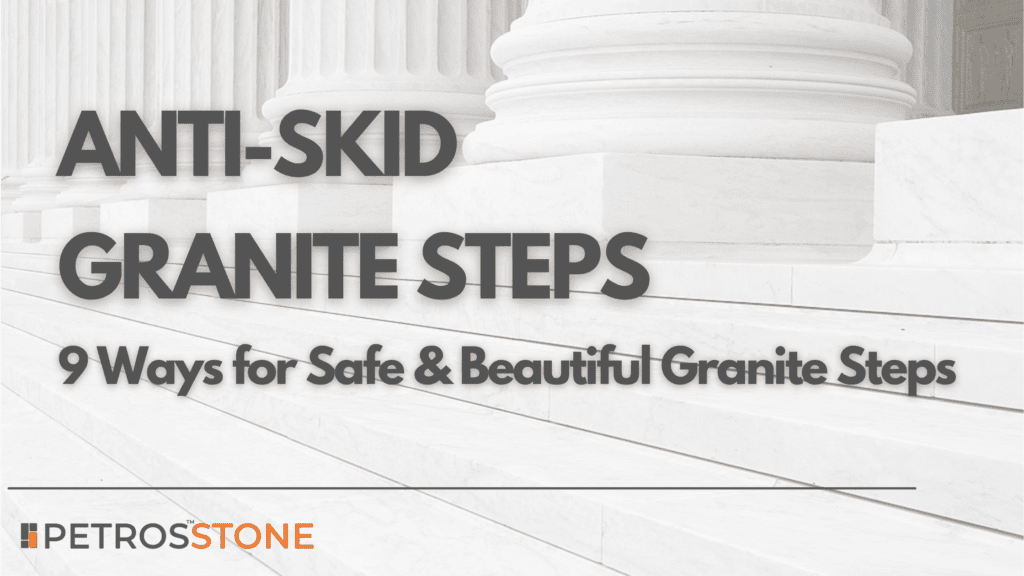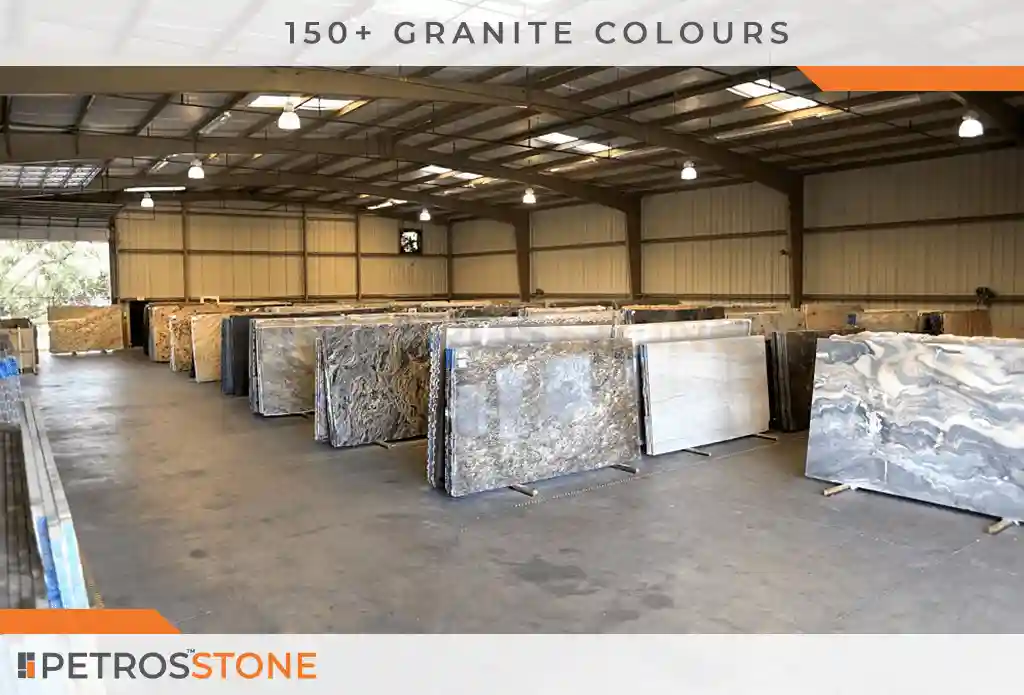Granite staircases make for the most elegant architectural elements in a residential or commercial space, but often turn out to be slippery and unsafe. Despite their elegance and variations, it becomes important to implement a few steps for safer anti-skid granite staircases.
Granite steps tend to get slippery because of the high level of polish that they possess. As a result, granite steps have little slip control, especially in wet conditions.
A much better alternative to natural granite staircases would be using Natural Quartz Stone Surfaces for staircases – it comes with natural anti-skid properties, while also retaining the luxurious look of natural marble or granite.
We have compiled eight ways of ensuring that your granite steps are safe, anti-skid and non-slippery. They are:
- Getting the Right Surface Finish – Leather, Lapatro, Flamed or Honed Finishes
- Grooves and Inlays
- Transparent Anti-Slip Paint or Tapes
- Sandblasting for Anti-Slip Granite Surfaces
- Elevating Edges with Bullnoses
- Carpeting the Stairs to Reduce Chances of Slipping
- Provide Proper Lighting on or Near the Stairs
- Provide Balusters and Gates
- Keep Steps Dry
Why must Staircases be Slip Resistant?
No matter how necessary and how beautiful a staircase is, it can turn out to be extremely dangerous if not dealt with carefully. According to research, over 300,000 patients visit hospitals every year as a result of accidents on a stair.
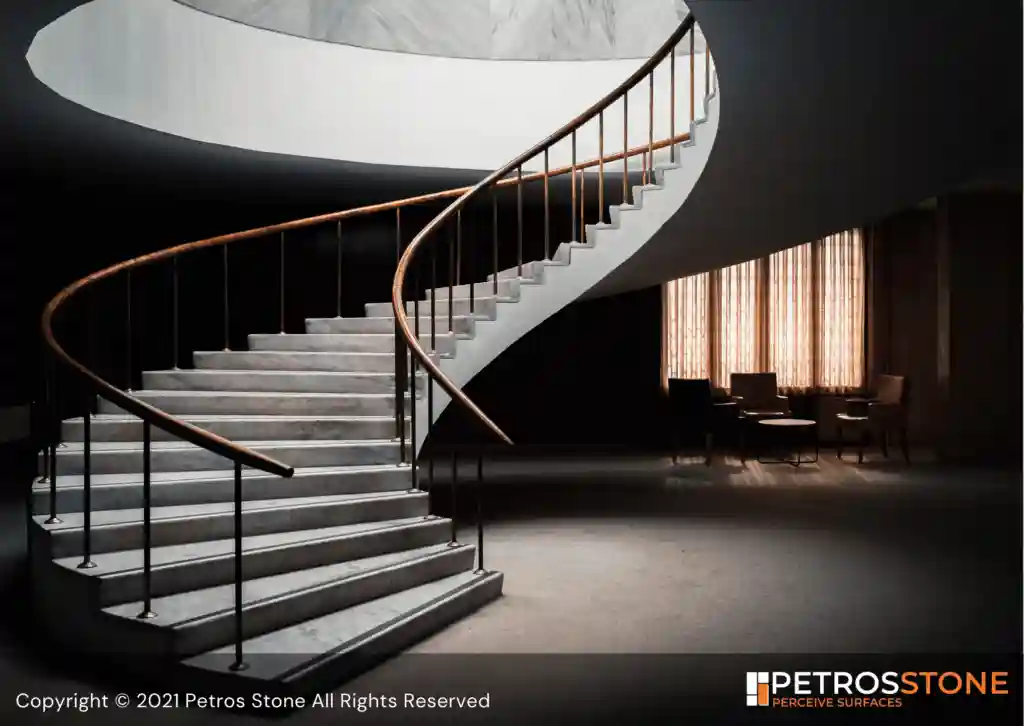
Slipping, tripping and falling continue to be the leading causes of stair-related accidents, especially in homes with the elderly and little children. In case the steps are highly polished or wet, the tendency to slip and fall over increases much more.
This underlines the importance of making staircases as safe as possible. Natural stones, such as granite staircases, must be treated specifically for anti-slip properties.
Granite Surface Finishes – For Anti-Skid Stairs
Most people prefer sleek, polished granite surfaces for greater aesthetic appeal. Polishing a natural stone such as granite involves grinding, sanding and buffing. The result is a mirror-like surface which makes the stone appear slightly darker in colour and richer in tone.
Despite being a popular choice for surface finish due to smoothness and reflectivity, polishing is not suitable for staircases as it can get extremely slippery. Surface finishes such as leather, honed and flamed finishes, among others, are considered safer compared to polished granite finish.
9 Ways for Anti-Skid Granite Steps
To avoid accidents and keep your granite steps safe for use by all age groups and user types, there are a few measures you can take either before or after installation.
1. Getting the Right Surface Finish
Surface finishes are not just a matter of aesthetics and visual impact, but also determine the texture and, therefore, the safety of granite staircases. We have already discussed how polished, extremely smooth surfaces are not desirable for staircases, which need a coarser finish for that extra degree of safety.
Leathered Finish
Leathered granite finish surfaces have gained quite some traction in recent times and are a comparatively modern style befitting contemporary interiors. This finish is characterised by a soft sheen that is less prominent than a polished granite surface.
A leathered finish begins with a honed surface, followed by running diamond-tipped brushes across the surface for the additional unique texture.
However, leathered finishes do not feature deep, sharp crevices. Instead, the textural variations are limited to dimple-like soft depths. For a natural stone like granite, which boasts of uniform colour and consistency throughout, a leathered finish can offer a much more subtle textural effect.
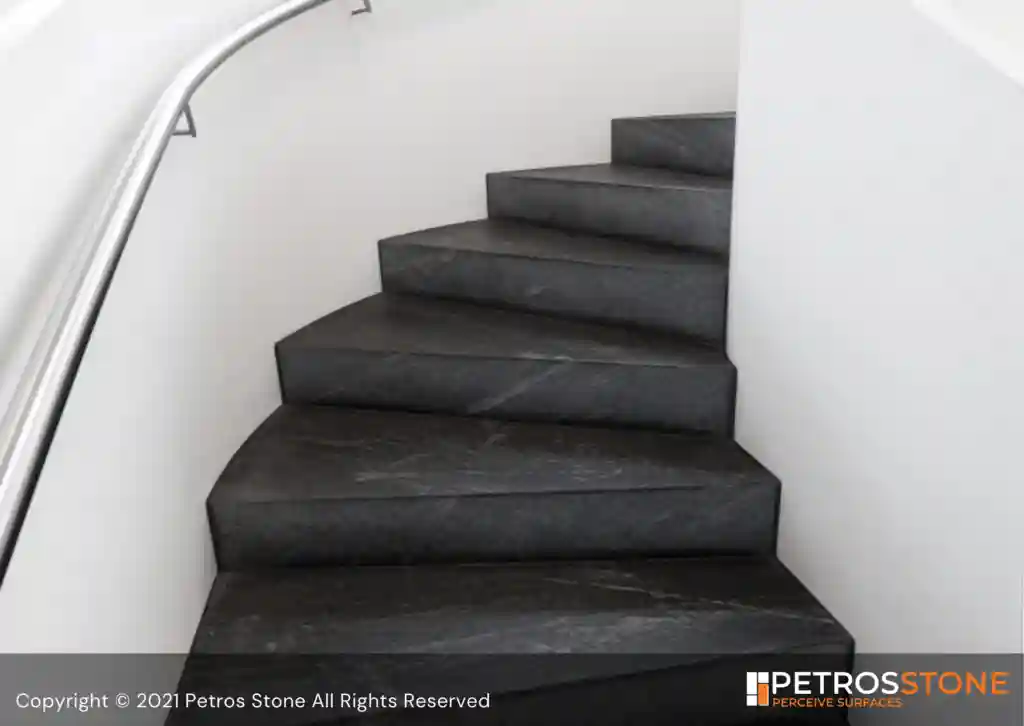
What makes a leathered finish anti-skid granite surface stand out is its textured, crinkled appearance packed with tiny pits and fissures. These undulations provide the much-needed resistance to granite surfaces against slip, thus making leathered finish an ideal choice for anti-skid staircases.
At the same time, leathered granite surfaces are incredibly easy to clean and maintain, besides being resistant to smudges, stains and spills due to closed pores. There is no alteration in the granite’s natural colour, which can again have multiple assortments – black, grey, brown, white, beige, and so on. Leathered surface finishes are one of the best ways to maintain both aesthetic appeal and the anti-slip safety of your staircases in style.
These undulations provide the much-needed resistance to granite surfaces against slip, thus making leathered finish an ideal choice for anti-skid staircases.
Lapatro Finish
The word Lapatro or Lappato has its origins in Italian vocabulary and involves grinding of the granite surface using an abrasive. The objective of using Lappato surface finish for granite is to remove any polishing from the stone surface along with any scratches and textural non-uniformity.
Similar to leathered finish, special-tipped brushes are used across the surface. However, there is an additional step post the brush treatment involving the application of special stones of number 800, 1500 and 3000 for achieving the final finish.

Lappato anti-skid granite finishes are characterised by a combination of matte and glossy looks, which is not as reflective as a polished surface but neither too granular nor excessively rough.
On the other hand, lappato granite finish provides the much-needed resistance to slipperiness while also maintaining an elegant overall look.
Lappato granite is a semi-polished finish which offers an easy-to-clean anti-slip surface that is ideal for staircases in homes, offices and more. Lappatro granite surfaces do not require any sealing. With simplicity and high-definition, this surface finish adds character and depth to any space.
Flamed Finish
As the name suggests, flamed finish granite surfaces involve heating the stone to high temperatures with an aim to burst the individual grains in the stone and change their colour. Flamed finish invariably leads to coarser texture and a more natural look.
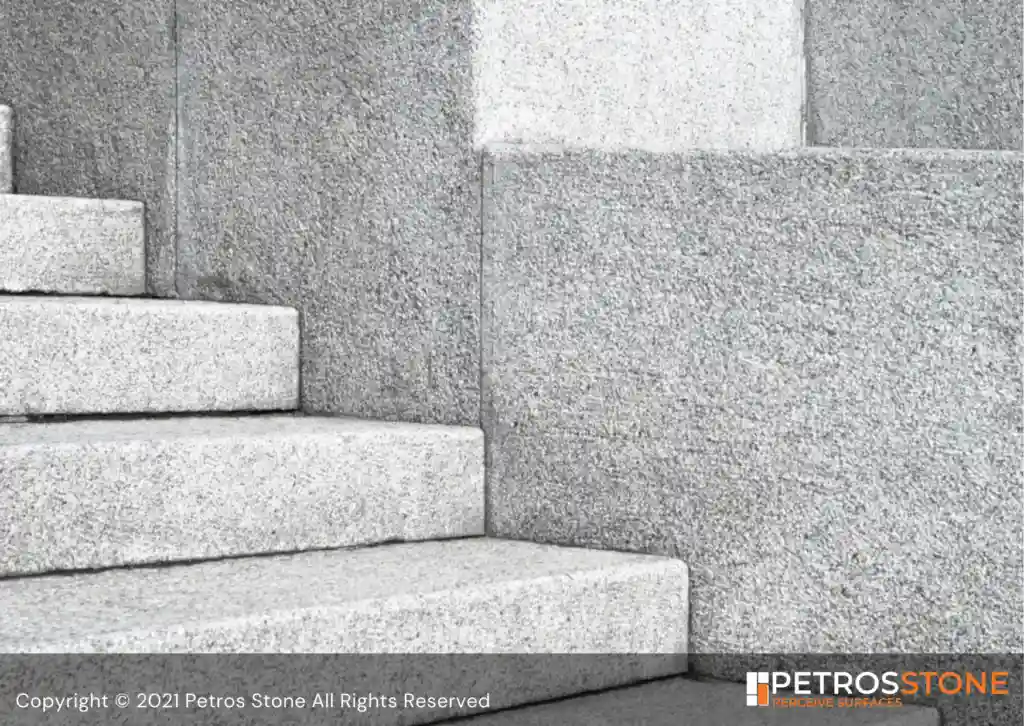
Compared to polished granite, which is darker and richer in colour, flamed finish granite surfaces bear a muted and faded tone. This is the reason flamed finish granite can work for almost any space, including exteriors. Therefore, if you are planning on introducing either an internal or external staircase, a flamed finish is your ideal choice.
Flamed finish anti-skid granite tends to not get slippery even when wet, making it incredibly safe for homes and public spaces to prevent any untoward incidents. The only downside is that this unique surface might not be the easiest to clean among the surface finish options listed here, especially indoors.
Honed Finish
A honed surface finish for granite takes the matte look a step further. It involves the application of abrasive pads for obtaining a flat, consistent finish. Honed granite surfaces offer a more warm, natural look to stone surfaces compared to polished ones. This makes them a top choice for homeowners these days.
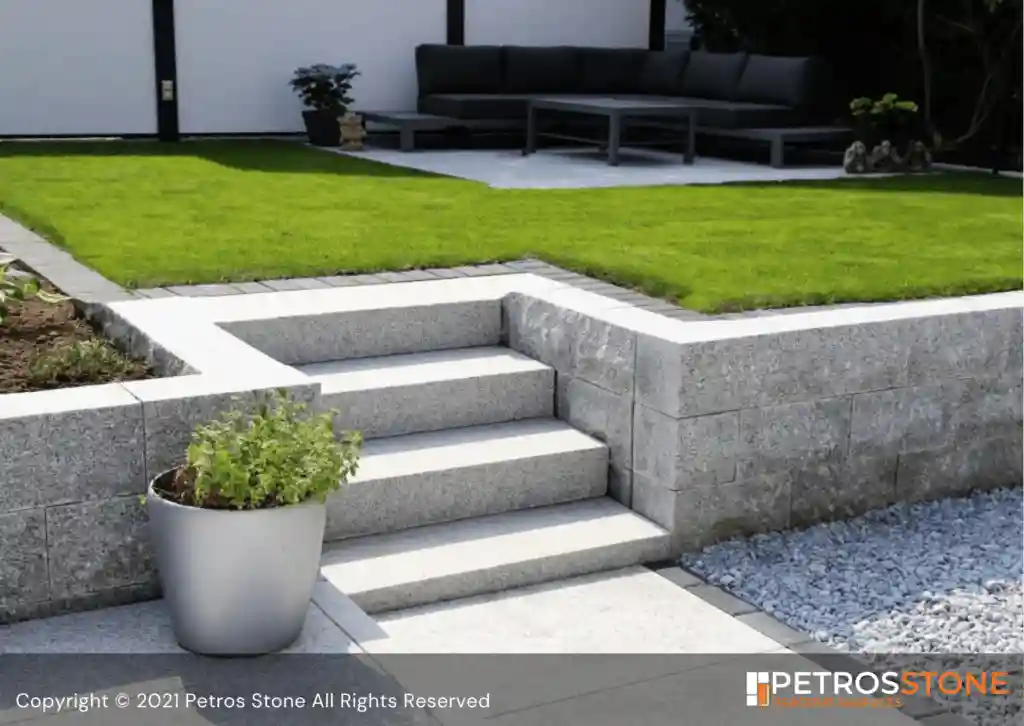
Honing a granite slab removes any ounce of gloss from it and leaves behind a textured, matte finish. Honed granite surfaces are also slightly lighter, and come in muted shades. Therefore, instead of a dark black surface, you get a shade that is grey.
The downside with a honed granite finish is that it leaves the stone more porous than a polished one. However, sealing the stone surface for greater resistance to moisture or spilling is quite easy. This surface treatment scores high in anti-slip properties. It is most suited for floors and staircases as it does not get slippery even when wet.
Flamed Leather Finish
For this surface finish, granite is first heat-treated with oxygen flame, following which the crystalline structure of the granite reorients. After this, various types of abrasives and brushes are used on the surface to give it a finer leather texture.
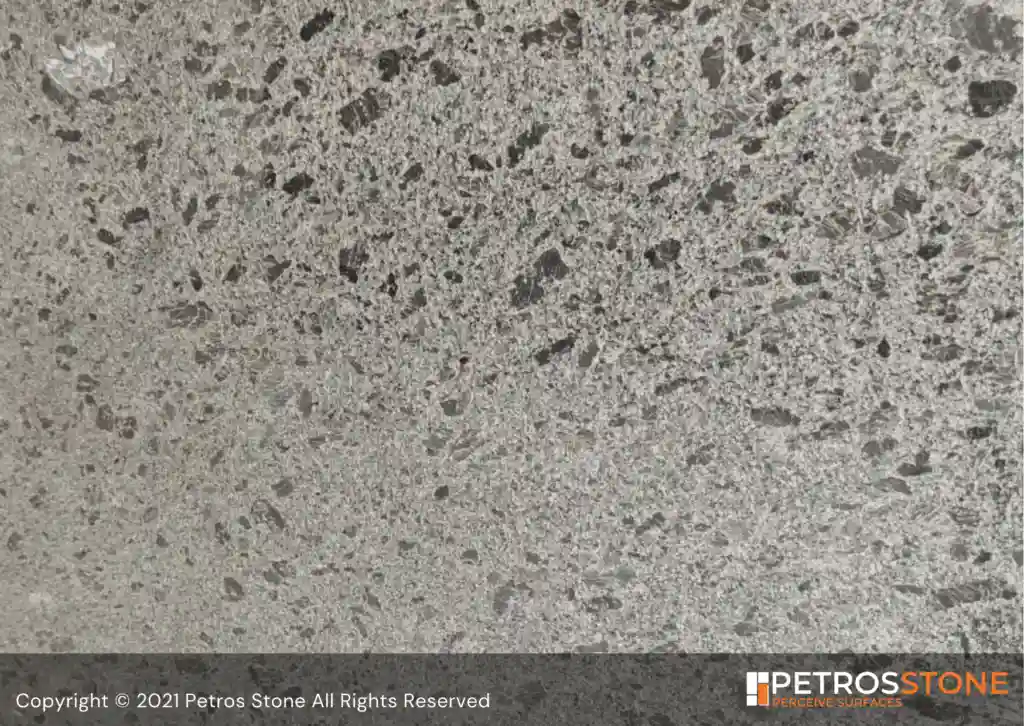
Flamed leather finish is a combination of thermal and mechanical interventions to make granite surfaces anti-skid, while not becoming too grainy for attracting dust. This surface finish makes for an ideal choice for staircases, outdoor patios, walls, door and window frames, and even countertops, if you desire.
3D Lapatro Finish
Some unique granite types with more than one minerals in their crystalline composition, or the ones with characteristic eyes, spots and design variations in the midst of their regular matrix are treated with 3D Lapatro finish. In this type of surface finish, the abrasives and brushes manage to erode the softer components of the matrix, while the harder eyes or design anomalies remain intact for a unique composition.
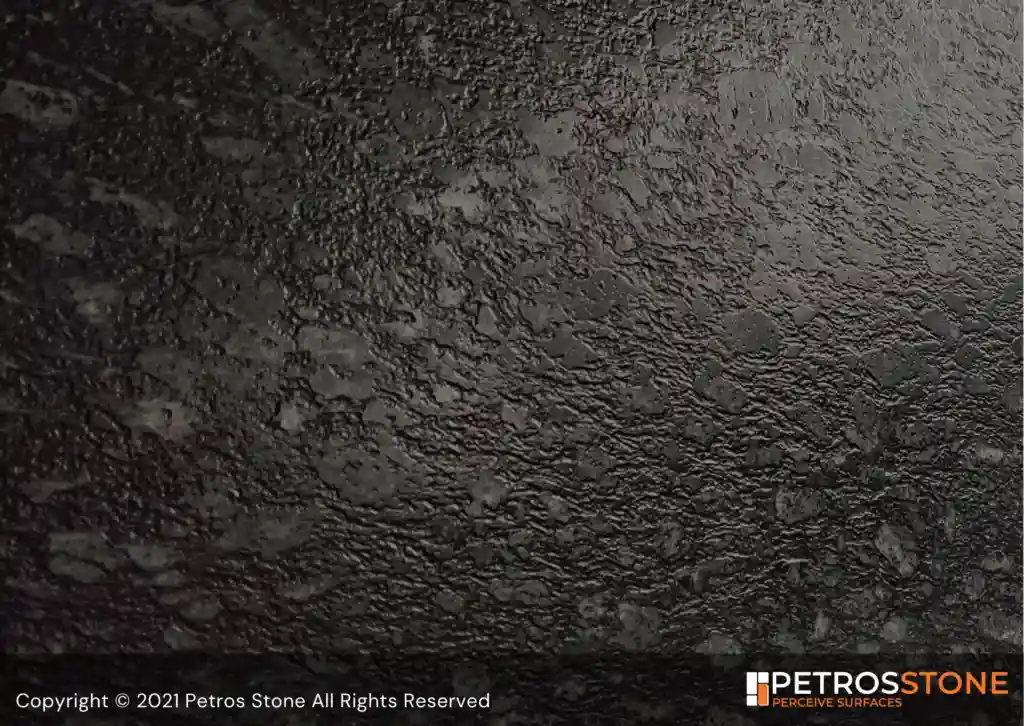
The eroding away of the background matrix and retention of the eyes or spots results in a three-dimensional finish with visible differences in depth or surface elevation due to selective abrasion. Such a surface becomes naturally anti-skid due to these undulations. After polishing these surfaces, the 3D character emanates even more clearly, lending a very pleasant textural surface.
The 3D Lapatro finish is an aggressive way of introducing slip resistance to granite surfaces. As such, they are applicable for use in staircases and outdoor patios, but are not useful as countertops.
2. Grooves and Inlays
Adding grooves and inlays to natural stones is one of the oldest ways of making anti-skid granite surfaces that are less slippery and safer to use. Though conventionally used in flooring, metal inlays are in popular use for staircases as well. Inlaying does not compromise on aesthetics, natural colours, patterns and textures; and yet, they can provide the much-needed anti-slip properties to your granite steps.
Adding Grooves
One of the most unique granite finish options would be to add grooves sawn across the face of the stone. Without altering the natural shade and tone of the granite, using grooves can make the surface completely resistant to slips and skidding. The method works wonders even for wet steps.
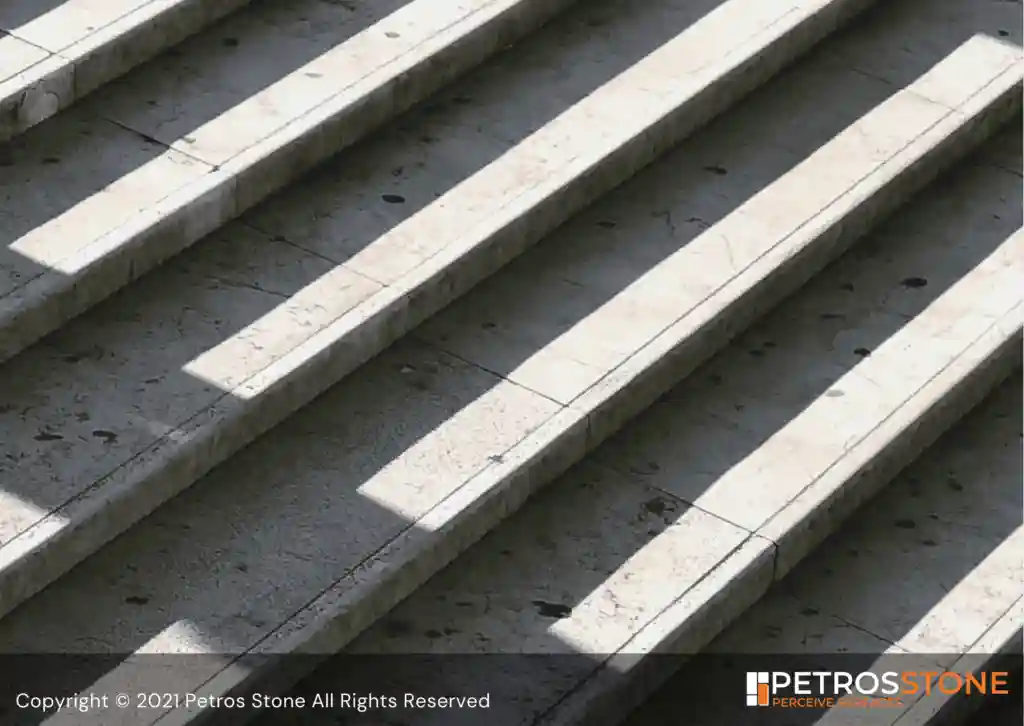
However, cleaning the grooves can turn out to be a matter of concern, especially in the case of frequently used staircases. The denser the grooves, the more challenging it can become to maintain such a staircase on a day-to-day basis.
Inlaying Metal on Edges
The art of metal inlaying has been passed down generation after generation. In this process, precious metals and gemstones are engraved in natural granite tiles, including brass, copper and gold. Metal inlay involves high-tech cutting, designing and styling to insert metal strips on the edges.
Inlaying with metals not only provides surface aberrations at regular intervals but also results in floors or staircases looking like a unique piece of art. These metal inlays are easy to clean, resistant to fire or corrosion and stand the tests of time. Add to that the already impressive durability of granite, and this combination is good to go.
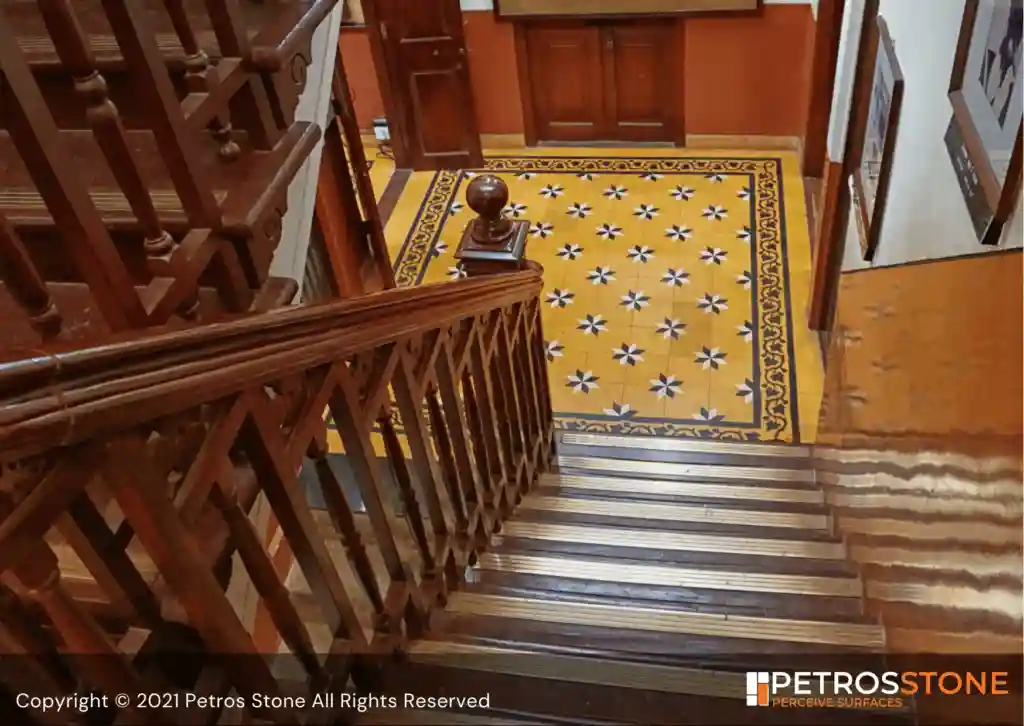
Simply put, if you are looking for a minimalistic yet luxurious design option with granite for your staircases, that also offers the much-needed resistance against slippery, inlaying with metals is a great option.
The choice of metal will dictate the overall look; brass for an artistic, luxurious look, copper for a charmingly rustic vibe and gold inlays for a classy, timeless design. The best part is that metal inlays can work with any shade of granite you pick, though our personal favourite would be using it with darker colours, such as black granite tiles.
3. Transparent Anti-Slip Paint or Tapes
These days, providing a protective layer of transparent paint for preventing slipperiness is also gaining a lot of traction. Aluminium oxide-based anti-slip paints are easily available in the market these days.
The biggest advantage of such paint application is that the granite steps remain slip-resistant even when wet. Certain products in the market assure quick drying, so you do not have to wait long before using the granite steps again.
At the same time, such anti-slip paints also offer resistance against acids, alkalis and corrosive chemicals, as well as UV radiations. This makes them useful for application on external staircases as well. You can apply these paints using conventional spray or roller techniques; they provide the benefits of negligible maintenance, easy repair and superior performance.
On the other hand, anti-slip tapes for staircases are also quite popular these days. Homeowners who have already installed their choice of granite stone surfaces find this option particularly useful. Available at reasonable prices, the anti-slip tapes need to be applied on the outer side of the tread to control your movements and prevent any skidding.
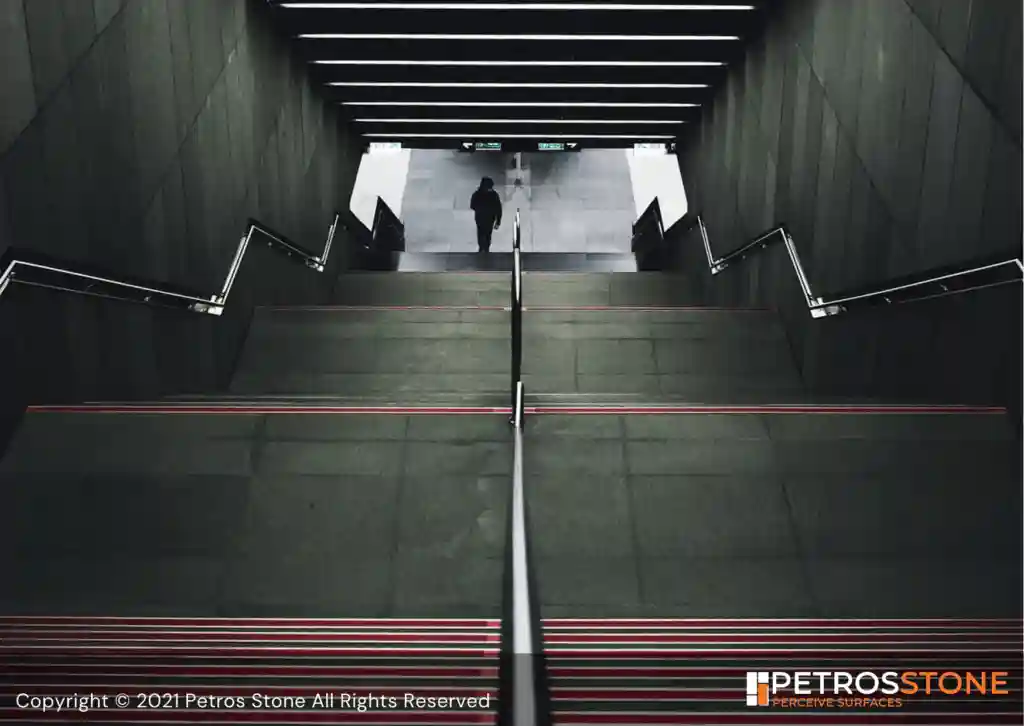
Anti-slip tapes score high on aesthetics as well. They come in interesting variations such as fluorescent lines and colourful stripes. If you are not looking for bright colours, you can opt for transparent tapes to flaunt your natural stone colour.
Such tapes provide a much-needed grip for facilitating easy movements while also being easy to clean and maintain. Public places such as shopping malls, stadiums and cinema halls often use anti-slip tapes on their stairs for both stunning visuals and as warning signs.
4. Sandblasting for Anti-Slip Granite Surfaces
Sandblasting, also known as abrasive blasting, involves propelling a stream of abrasive material against a surface under high pressure. The aim is to alter the texture of the stone surface – from smooth to rough, or rough to smooth. At the same time, sandblasting helps in getting rid of surface contaminants from granite tiles.
When used for granite surfaces, sandblasting comprises smoothing, shaping and cleaning the surface. The result is a uniform yet far from the polished textured stone surface. This surface finish brings out the sparkling crystals of granite by enhancing the crystal properties of the stone.
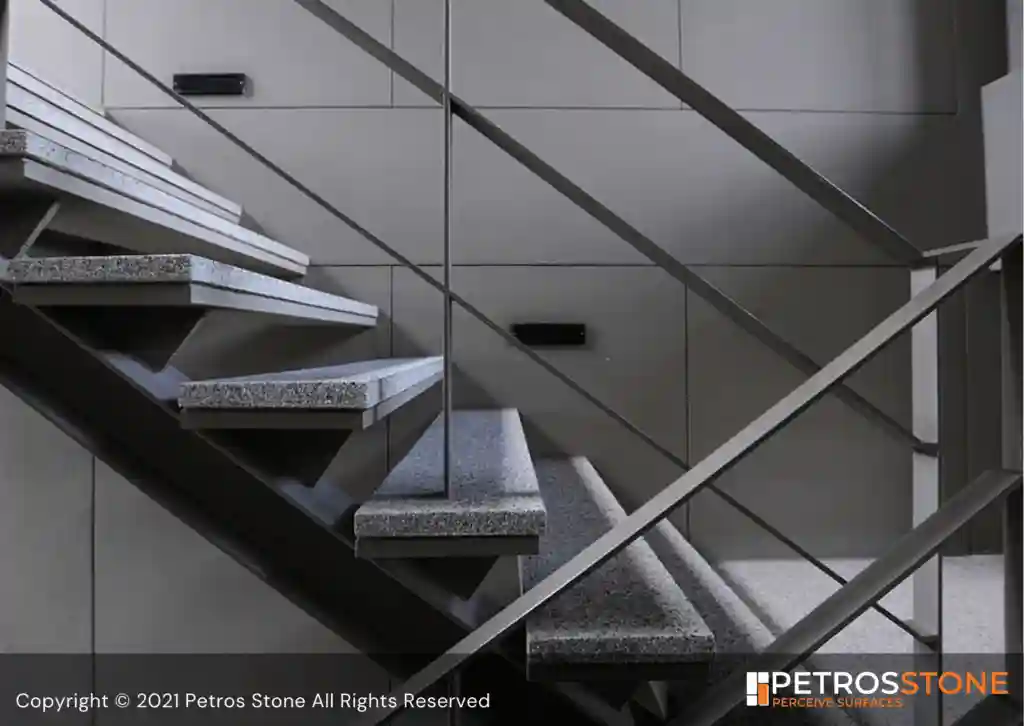
This is a much quicker process compared to other forms of blasting. However, it is quite elaborate compared to other anti-slip treatments mentioned above.
Nonetheless, sandblasting offers a long-term, durable and attractive solution to slippery granite surfaces. This method is best suited for staircases in commercial or public spaces, as it is more expensive than some other methods that can be used in homes instead.
5. Elevating Edges with Bullnoses
A bullnose edge refers to the outward-projecting, convex rounding of stone on steps. Bullnose edges have been in vogue for centuries now, and add both aesthetics and safety to staircases. At the same time, they offer much-needed protection against skidding and falling off steps.
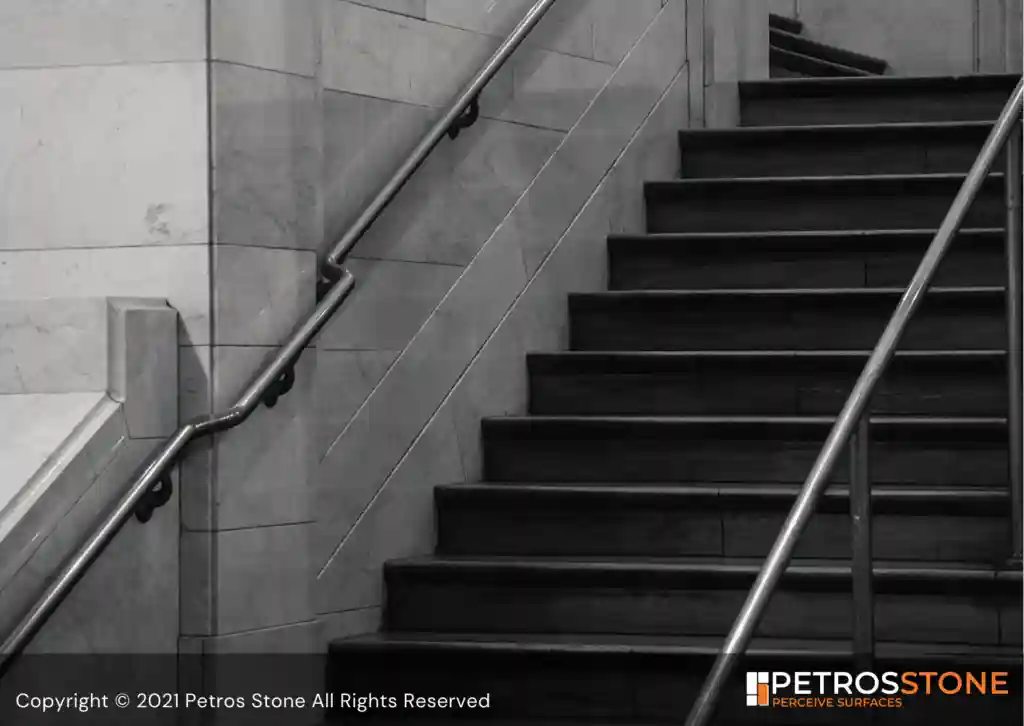
This type of edge profile is not strictly used for slip resistance. However, it certainly makes granite stairs safer to use than blunt square edges. At the same time, bullnoses add a timeless look to your steps. They can be implemented in a variety of edge styles, such as arris, tumbled, chipped, rebate and mitred.
6. Carpeting the Stairs to Reduce Chances of Slipping
One of the most conventional ways to reduce the slipperiness of your steps at home is to clad them with a carpet of your choice. Low pile carpets – ¾ inch or less – offer much-needed stability and resilience. Besides, they bring anti-skid properties and plush style options to the table in keeping with your interiors.
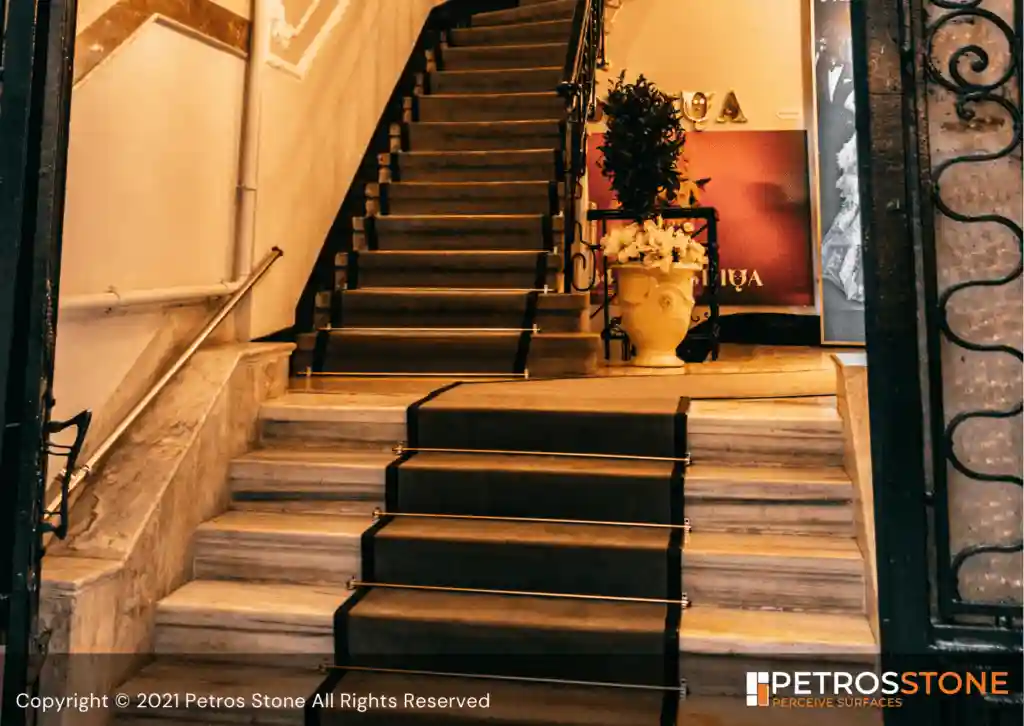
Carpeting your stairs, however, will lead to either some or all of your natural granite surface getting hidden from view. Many prefer to cover the entire width of staircases with carpets, while some others use them to cover a smaller portion in the middle. At the same time, water and liquids are no good friends to carpets. It can become quite a task to handle and maintain carpeted staircases in case of liquid spillage.
Nevertheless, carpets for staircases continue to be one of the most preferred ways of preventing accidents, maintaining a longer life for natural stone surfaces and easier maintenance.
Extra Tips for Stair Safety
Stairway accidents are a common cause of concern in both households and public places. This calls for extra stress on their safety through additional measures.
One way of ensuring this is by providing anti-slip stone surface finishes or treatments, as we have already discussed. However, there are some additional measures to keep in mind when designing or maintaining staircases for extra safety.
7. Provide Proper Lighting on or Near the Stairs
Always ensure that your stairwell is adequately lit to prevent any cases of tripping or skidding. Ideally, all staircase landings, including the first riser should be provided with good lighting. This ensures that the stair fleet is also well-lit. Staircase footlights are another modern and functional option that help improve visibility.
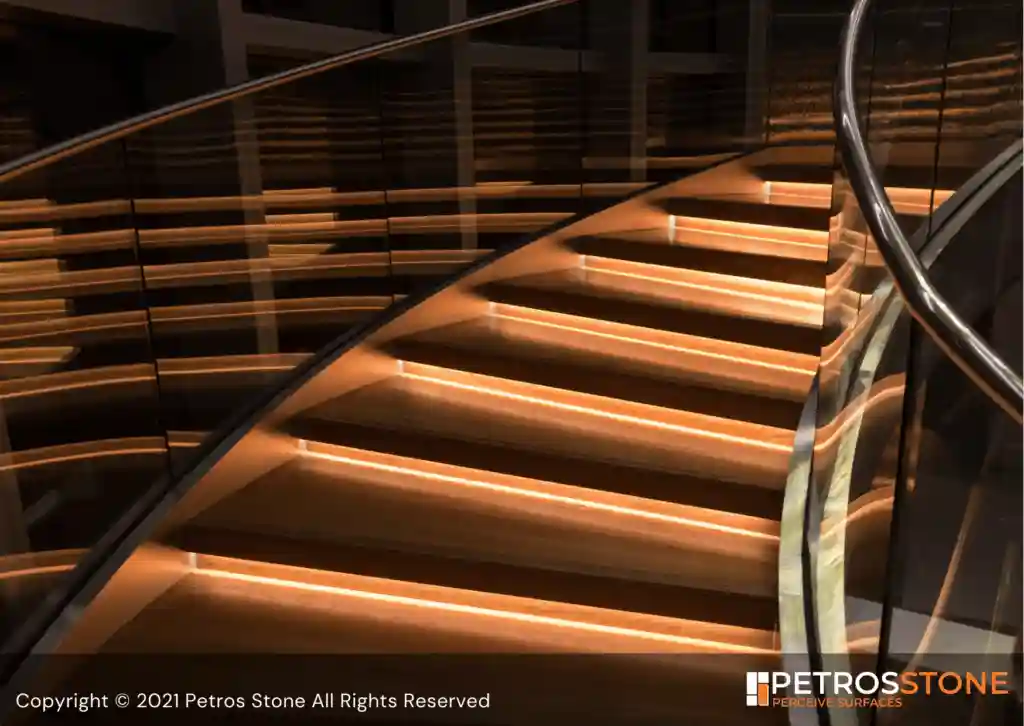
Lighting should ideally be from a higher point; therefore, you might want to consider ceiling or high wall-mounted lights near your staircase. At the same time, choice lighting designs can add to the aesthetic appeal of your staircase. The right lighting can bring out the shades of granite used for a warm/cool, dark/bright visual impact, and so on.
8. Provide Balusters and Gates
Staircase railings are extremely important from the basic safety point of view. However, balusters have been out of fashion in contemporary designs for quite some time now. Yet, one cannot deny how important they are for staircase safety, especially in homes with children, the elderly or pets.
Providing balusters along your staircase ensures that little children or pets do not fall over from the gaps between the railing the surface of the steps. At the same time, balustrades on each landing can provide considerable support for the elderly while they use the staircase.

Similarly, many homes with pets and children opt for staircase gates. These can be installed without any hassles on the landing and locked from either side. This is to prevent children or pets from accessing the flight of steps for safety reasons. Either they have not learnt using the stairs yet or you are afraid they might cross over and enter areas you do not want them to, such as at night or when they are alone.
This is why balusters and gates are growing in importance especially in residential spaces. While balusters are both safe and aesthetic, stair gates can be moved/open/shut as and when needed. Therefore, they rarely come in the way of visual appeal despite their utilitarian value.
9. Keep Steps Dry
The biggest enemy to slip resistance is wet steps. When it comes to polished surfaces, such as marble and granite steps, leaving the stairs wet can lead to major accidents. A majority of accidents on stairways are caused due to wet surfaces.
This makes it important to keep steps dry at all times. Any spillage of water or liquids must be taken care of immediately. Even when stairs are carpeted, any liquid spillage can cause an irritating smell and damage to the fabric. Therefore, it is important to keep steps dry at all times with the help of the right equipment and tools.
